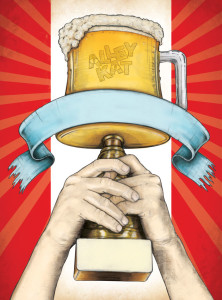The current issue of Vue Weekly is their annual Beer Issue, where significantly more column inches are devoted to the grand elixir than the usual To The Pint column every couple weeks. This year I am the author of three pieces in the section. And I decided to go with a overarching theme, looking at the past, present and future of craft beer in Edmonton and Canada.
The cover story looks at the recent Canadian Brewing Awards and in particular at Alley Kat‘s big win with Beer of the Year. I also look at some of the other Alberta-based winners and even stick a toe into the Minhas debate. I won’t go into that piece much as I wrote extensively on the CBAs on this site (here). But you can read the whole cover story here.
Given that the cover looks squarely at the present, I shift gears in the second piece to offer a quick history of craft beer in Canada ( read it here). I work through the pioneers of the industry, including Horseshoe Bay, Granville Island and others, but what I think the piece really contributes is a recognition that craft beer has grown in waves and each wave had its distinct character. The first wave in the mid-1980s included Big Rock, Upper Canada, Amsterdam and others. By today’s standards their beer were/are fairly safe – brown ales, wheat ales, moderately hopped pale ales – but we need to keep in mind that at the time those beer were ground breaking. They weren’t yellow lagers. And everyone of those breweries had to chart a completely unmarked and uncleared trail.
The second wave consisted of the mid-1990s breweries, Alley Kat and Wildrose among them. There were dozens that popped up about 20 years ago. These brewers differed from their older siblings by branching out a bit farther. They played more with hops and branched out the kinds of styles they were willing to play with. I also think these breweries – possibly learning for the experience of the first wave – were more focussed on local markets. They didn’t (and for the most part still don’t) have big ambitions to sweep across Canada or into the U.S. like Big Rock, Granville and Okanagan Springs did. I think they figured out that anchoring in community helped build loyalty.
The third wave is just emerging. Their breweries are smaller and more intimate but their beer are big, brash and bold. For the latest round of brewers hops is a mandatory flavour as they are closer to emulating their American cousins south of the border. It makes sense to me. This is a generation that has only known a world where craft beer is available. It expands their horizons and sense of what is possible in a way that Ed McNally could never have imagined.
The third article (read here) turns its attention to the future. What will happen in Edmonton’s beer scene in the coming years? Now, the piece ends up being a bit of a thought piece, exploring why Edmonton lags in terms of craft breweries and brewpubs and how that might shift in coming years. It teases at some announcements in the coming weeks and months (keep your eye on this website for scoops!) and suggests that while Edmonton continues to be behind other cities of similar size, things are starting to change for the better.
From the early struggles of Horseshoe Bay brewpub in Victoria, to surpise victories at the CBAs, to the latest barrel-aging program of the upstart breweries in the province, craft beer has charted an interesting course over the past three decades. And I am looking forward to being around for a couple more decades to see what happens next.



July 12, 2015 at 11:35 PM
Glad to see a rising interest in barrel-aging. I had the good fortune of coming across one from Smuggler’s, a vintage ale aged in a wine barrel. I’ve only seen it once, but it was amazing. Been trying to order a case through my local liquor store, but so far no luck. That’s okay though, as I’ll keep looking for others (more local of course.) Please alert me as new articles are posted (box checked). Thx.